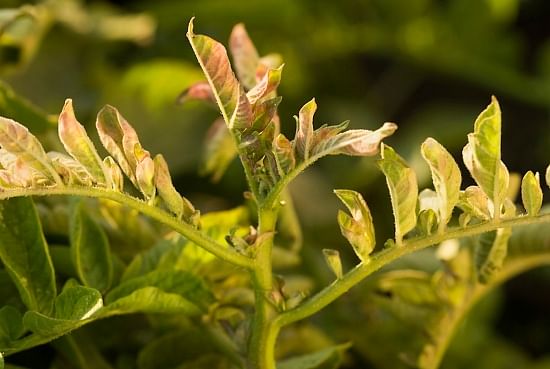USDA-Agricultural Research Service (ARS)
Biobased approaches examined in fight against zebra chip

Thanks to investigations by scientists-turned-detectives with the U.S. Department of Agriculture (USDA) and other agencies, potato growers in the western United States and abroad now know the identities of the pathogen-insect duo responsible for outbreaks of the costly tuber disease known as "zebra chip."
In the near term, the discovery is helping growers in affected regions improve their timing and use of insecticide sprays to prevent the potato psyllid, Bactericera cockerelli, from feeding on and infecting potato crops with the Zebra chip bacterium, Liberibacter solanacearum. Over the longer term, researchers aim to recommend alternative controls for use in integrated approaches to managing the disease, according to Joseph Munyaneza, an entomologist at the Agricultural Research Service (ARS) Yakima Agricultural Research Laboratory in Wapato, Wash.
ARS is USDA's principal intramural scientific research agency, and this research supports the USDA priority of promoting international food security.
Besides savings on insecticide use, other benefits of an integrated approach include preservation of beneficial insects, prevention of secondary pests, and decreased risk of insecticide resistance developing in psyllid populations.
Since 2005, Munyaneza has participated on a multi-disciplinary team of scientists from government, academia and industry conducting research to minimize the incidence of Zebra chip, so-named for the dark stripes it forms inside afflicted tubers.Their investigations include trials of:
- kaolin particle film, a reflective clay-based powder that can be mixed with water to form a protective barrier on plants. In tests, it disrupted psyllid feeding and egg-laying,
- biorational insecticides, including a mineral oil formulation that deterred 94 percent of psyllids,.
- Metarhizium anisopliae, a beneficial fungus that reduced psyllid eggs and nymphs by 45 to 67 percent,
- potato germplasm that showed resistance to psyllids in the form of reduced feeding by the pest, and
- monitoring of psyllid migration patterns to help predict the development of Zebra chip in potato crops—including via populations of the pest originating in Texas, where the disease was first reported in fields near McAllen and Pearsall in 2000.
Like to receive news like this by email? Join and Subscribe!
NEW! Join Our BlueSky Channel for regular updates!
Uitgelichte Bedrijven
Sponsored Content
Sponsored Content
Sponsored Content
Sponsored Content
Sponsored Content










